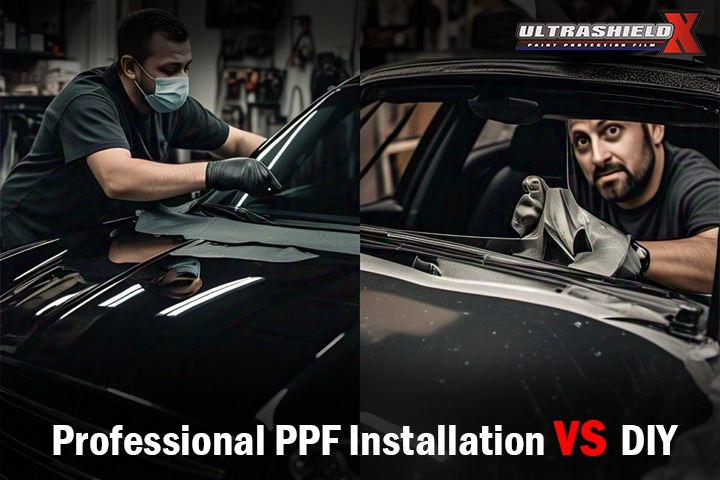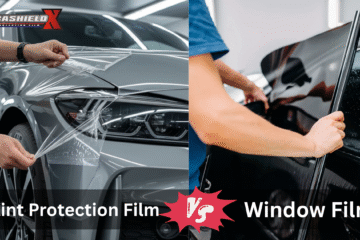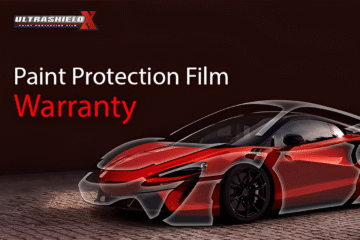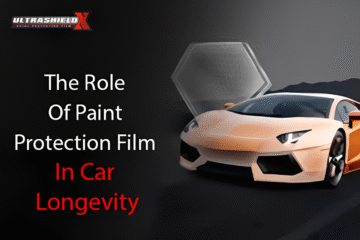This Paint Protection Film has become one of the most popular solutions when it comes to preserving the original car paint and protecting it from debris, dust, scratches, tree sap, water spots, and more. It provides an incredible advantage. One of the most critical decisions you want to make while considering PPF from a professional installer is to hire or take a DIY approach.
In this blog, we will dive into both professional and DIY PPF installers and their opposition. Towards the end, you will be able to make the best decision based on your needs, budget, and skill level.

What is Paint Protection Film ?
Paint Protection Film is a thin, apparent film made from polyurethane, and it is used to safeguard the painted surfaces of the automobile from environmental factors such as dust, scratches, stains, and UV damage. The film is durable and invisible, which continues to maintain the beauty of the automobile by giving long-term protection. It is especially well-known for protecting highly impactful regions with bumpers, side mirrors, hoods, and fenders.
While there are several advantages to Paint Protection Film, the setup approach distinguishes a remarkable outcome. This is where the choice to visit an expert or DIY is a game-changer.
Professional PPF setup Advantages
Here are the benefits of getting Paint Protection Film installation from professionals:
1). Competence and Enjoyment
One of the primary motives for choosing a professional setup alternative is enjoyment. The expert car detailer who does a proper Paint Protection Film installation. As they hold the knowledge and skills with a wide variety of vehicle model PPF installations, they ensure that the film is accurately placed, even without any errors. They understand the difference in the material and recognize a way to install it correctly, especially on complicated curves, edges, and seams.
2). High-Quality Consequences
Professional installers use the best films and superior techniques to ensure an error-free installation. They have proper knowledge and skills of this Paint Protection Film and are equipped with the devices required to install PPF without leaving bubbles, wrinkles, or visible seams (such as a hot air gun, squeegees, and trimming gear). It might be a spontaneous end that appears easy and invisible.
3). Time and Comfort
The paint protection film installation can be a time-consuming task, especially for any first-time installer. As this requires the surface to be clean, the film application gets easy and ensures that all air bubbles are removed. But if you try to do it by yourself, it can take all day or more time, depending on the complexity of the process. On the other hand, a professional installer can typically complete the work in less time than if you do a DIY installation of PPF. As skilled car detailers, ensure that you can get back on the street soon with your PPF car.
4). Warranty and Protection
Many expert Paint Protection Film installers offer warranties. If any problems arise, such as peeling, lifting, or bubbling, the installer will generally repair these problems at no extra paint protection film cost. This peace of mind is especially a gem in case you need to make sure that your PPF stays effective for the long term.
5). Advanced Tools and Techniques
Professionals use the latest equipment, which includes Paint Protection Film cutting machines, to ensure the film is cut precisely to your car’s model. This helps keep away from mistakes that are common with DIY methods, where a person cutting for any model car may get inaccurate due to measurements or harsh edges. Additionally, professionals have access to hot air guns and specialized equipment that assist in molding the PPF into place more effectively.
Drawbacks of Professional Installation
Despite all of the benefits, professional paint protection film installation has its downsides:
- Cost: Professional setup can be costly, often costing hundreds or a considerable amount of money, depending on the size of the automobile and the area’s space that needs to be covered. The high charge amount can be a big issue for a few car owners.
- Limited Control: When you rent a professional, you are placing your trust in someone else’s palms. While most experts are incredibly skilled, a few might not meet your expectations. Moreover, you can no longer have complete control over the kind of film used or the installation method.
DIY PPF Installation Advanatges
Below are the benefits of choosing the DIY installation option.
For those on a budget or searching for an extra hands-on approach, DIY paint protection film installation is an attractive option. With the proper tools, practice, and patience, it is a feasible option to achieve expert-level outcomes on your own. But the question is, is it worth it?
1). Cost Savings
The biggest gain of doing it yourself is the cost savings. A professional setup can be pricey, and many DIY lovers choose to install paint protection film cost themselves to avoid the additional labour cost. The price of the film itself can vary. However, it’s usually a lot cheaper than paying for expert services. For those willing to invest effort and time, DIY PPF installation can save you lots of cash.
2). Full Control Over the Process
When you put in paint protection film yourself, you have complete management over the whole method. You can select the relevant area you want to cover, the PPF film brand you wish to place on your car and the installation technique you want to use. If you are careful about the safety of your vehicle, make sure each item is in its best form.
3). Learning Experience
DIY Paint Protection Film setup offers a unique possibility for researching new capabilities. For people who are obsessed with automotive care, this could be a worthwhile and fulfilling idea. It’s also a high-quality way to improve your understanding of vehicle preservation and get acquainted with the gear and techniques used in the process.
Drawbacks of DIY PPF Installation
While DIY installation in addition may look like a good idea, there are many demanding conditions and potential risks:
- Lack of experience: The main disadvantage is a lack of experience. If you have never installed a paint protection film before, it is easy to make errors that would be completely noticeable. These may include air bubbles, wrinkles, bugs or poor side finish. Such errors can destroy the effectiveness of the film, which can lead to fewer results.
- Time: DIY installation is labour-intensive. Even if you are experienced, the installer and interest are required to install PPF. It can take hours to cover a single part of the car, and you need to make sure the film is installed correctly without bubbles or wrinkles.
- Risk of loss: If the film is incorrectly installed, you cause trouble by damaging the vehicle’s original paint. In addition, mistakes such as placing the film on the trimming edges very quickly or incorrectly give you a negative result, such as wrinkles or bubble formation.
- Lack of Professional Tools: Professional installers use specialized gear like hot air guns, squeegees, and lubrication liquid. DIY installers may additionally lack these tools or be unable to apply them effectively, resulting in much less effective Paint Protection Film.
Which Option Is Right for You?
So, which option do you have to choose—expert setup or DIY PPF? The solution depends on several elements:
Choose Professional Installation If:
Here are the top reasons you should consider a professional installer of the PPF:
- You want an excellent end: If you are looking for a great, expert result, a good way to enhance the appearance and toughness of your car’s paint, hiring a pro is the best solution to go with.
- Quicker on time: Professional installers will get the activity done quickly and efficiently without you having to spend any extra hours on the completion of the work.
You want peace of mind: With an assurance that if there were any issues, they would be entirely handled by the expert car detailers.
Choose DIY Installation If:
You’re in a price range: If you’re looking to save money and are inclined to invest effort and time into studying, a DIY setup is a cost-effective alternative.
- Your experience operating on automobiles: If you are someone who likes to do projects by yourself and explore new capabilities, installing PPF by yourself can be a rewarding experience.
- You’re putting in PPF on non-essential areas: If you’re masking smaller or less visible elements of the car and aren’t as concerned about perfection, DIY may be an excellent match.
Conclusion
Whether you choose to go with a professional PPF setup or try a DIY method, it’s essential to remember that you select a good quality Paint Protection Film like UltrashieldX as its base film raw material is taken from prominent companies like BASF, Wanhua, Huntsman, Lubrizol, and Convestro. Even the adhesive layer of the PPF is made from the eminent Ashland glue. Therefore, it is one of your vehicle’s best paint protection films.
You also need to consider your personal skill level, the importance of the end, and your price range. While professional installation offers understanding, comfort, and a pleasant experience, DIY installation can save money and provide extra flexibility for those who are up for the task. Both alternatives have their pros and cons, but the ultimate decision comes all the way down to your priorities.
FAQS
Q1. Is PPF hard to install by yourself?
Ans. Usually, it is not that hard to use the right techniques and tools; you can install a PPF by yourself, but if you have even one of them, then the PPF installation procedure can go completely wrong.
Q2. Why is car PPF so costly?
Ans. The car PPF is very costly because prominent PPF manufacturers Paint Protection Film holds the latest technology, such as instant healing and self-healing properties. Apart from this, they also give several benefits, such as safeguarding from numerous environmental issues like debris, dust, tree sap, harmful UV rays, stone chips, etc.
Q3. Can I remove the PPF from the car?
Ans. Yes, you can remove the PPF from the car, but expert car detailers are still advised to get it removed as they would be able to remove it properly without chipping off the original paint of the vehicle.
Q4. Which is the best company for PPF?
Ans. UltrashieldX is one of the best companies for PPF, as its raw material for base film is taken from prominent companies like BASF, Wanhua, Huntsman, Lubrizol, and Convestro. Even the adhesive layer of the PPF is made from the eminent Ashland glue.
Q5. Can I do PPF on my car by myself?
Ans. Yes, you can do PPF by yourself on your car, but if you don’t have the specified tools, years of experience, and skill, along with good quality paint protection film for car, then the result of PPF and its effectiveness won’t be as it should be.
Q6. How to choose a PPF installer?
Ans. Here are the pointers by which you can select a good PPF installer for your vehicle:
- Car detailers experience
- Look for the latest technology, like self-healing and instant healing properties
- Manufacturer Warranty
- Manufacturer company reputation, and many more.



0 Comments